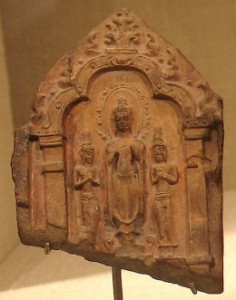Posted on 12 April 2016 by Buddhism Now
 The Buddha taught that looking after the precepts isn’t hard if you look after yourself. If any forms of harm are about to arise by way of your bodily actions or speech, then if mindfulness is in place, you’ll recognize them. You’ll have a sense of right and wrong. This is how you look after your precepts. Your body and speech depend on you. This is the first step.
The Buddha taught that looking after the precepts isn’t hard if you look after yourself. If any forms of harm are about to arise by way of your bodily actions or speech, then if mindfulness is in place, you’ll recognize them. You’ll have a sense of right and wrong. This is how you look after your precepts. Your body and speech depend on you. This is the first step.
If you can look after your bodily actions and speech, then they’re beautiful. At ease. Your manners, your comings and goings, your speech, are all beautiful. This kind of beauty is the beauty that comes from having someone shape and mould them — someone who keeps looking after them and contemplating them all the time. It’s like our home, our sala, our huts, and their surrounding areas. If there’s someone to sweep them and look after them, they’re beautiful. They’re not dirty — because there’s someone to look after them. It’s because there’s someone looking after them that they can be beautiful.
The same with our bodily actions and speech: If there’s someone looking after them, they’re beautiful. Evil, obscene, dirty things can’t arise. Our practice is beautiful. fidi-kalyāṇaṁ, majjhe-kalyāṇaṁ, pariyosāna-kalyāṇaṁ: Beautiful in the beginning, beautiful in the middle, beautiful in the end. What does this refer to? One, virtue; two, concentration; three, discernment. These things are beautiful. They start by being beautiful in the beginning. If the beginning is beautiful, then the middle is beautiful. If we can exercise restraint with ease, always being watchful and careful to the point where our mind is firmly established in the act of looking after things and exercising restraint, always intent, always firm, then this quality of being firm in your duties, firm in your restraint, is given a different name. It’s called “concentration.”
The quality of exercising restraint, always looking after your body, looking after your speech, looking after all the things that would arise in this way: This is called “virtue.” The quality of being firm in your restraint is called something else: “concentration,” the firm establishing of the mind. It’s firm in this preoccupation, firm in that preoccupation, always restrained. This is called concentration. This level of concentration is external, but it has an internal side as well. Make sure to have this with you always. This has to come first.
 When you’re firm in these things — when you have virtue and concentration — then you will also have the quality of contemplating what’s right and what’s wrong. “Is this right?” “Is this wrong?” These questions will arise with every preoccupation that comes into the mind: when sights make contact, when sounds make contact, when smells make contact, when tactile sensations make contact, when ideas make contact.
When you’re firm in these things — when you have virtue and concentration — then you will also have the quality of contemplating what’s right and what’s wrong. “Is this right?” “Is this wrong?” These questions will arise with every preoccupation that comes into the mind: when sights make contact, when sounds make contact, when smells make contact, when tactile sensations make contact, when ideas make contact.
A knower will appear, sometimes happy, sometimes sad, sometimes pleased. It will know good preoccupations, bad preoccupations. You’ll get to see all kinds of things. If you’re restrained, you’ll get to see all kinds of things coming in, as well as the reactions in the mind, in the knower. You’ll be able to contemplate them. Because you’ve exercised restraint and are firm in your restraint, then whatever passes in there, the reactions in terms of your bodily actions, your speech, and your mind will show themselves. Things good or evil, right or wrong will arise. And then when you choose or select the proper preoccupation, this is what’s called “a thin layer of discernment.” This discernment will appear in your heart. This is called virtue, concentration, and discernment all at once. This is how they first arise.
No comments:
Post a Comment